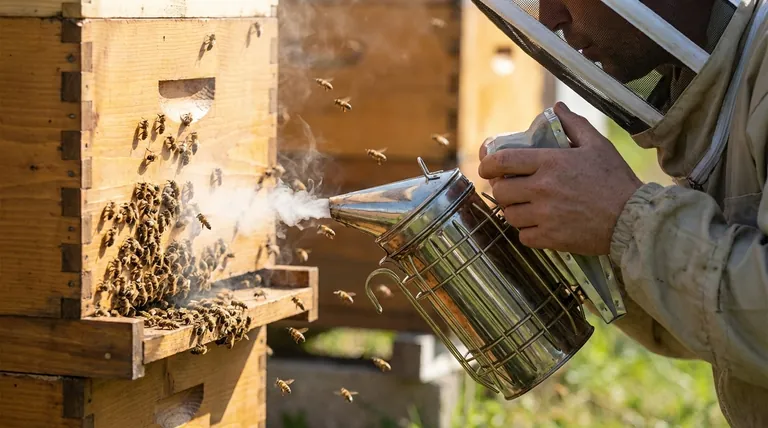In short, smoke calms honey bees by disrupting their communication. It works by masking the alarm pheromones that guard bees release to signal a threat, which effectively prevents the colony from organizing a large-scale defensive response. This allows a beekeeper to perform inspections without causing widespread agitation.
The core principle is not sedation, but sensory interference. Smoke overwhelms the bees' ability to smell danger, interrupting their natural defense system and tricking them into remaining calm during a perceived intrusion.

The Science of Smoke: A Communication Breakdown
To understand why smoke is effective, you must first understand how a honey bee colony communicates danger. This process is driven by chemical signals, not conscious thought.
The Role of Alarm Pheromones
When a guard bee perceives a threat, such as a beekeeper opening the hive, it releases alarm pheromones. These chemicals act as an emergency siren for the rest of the colony.
This signal instantly alerts other bees to the danger, triggering a coordinated defensive response where thousands of bees may become agitated and prepared to sting.
How Smoke Masks the Signal
Smoke particles physically bind to the bees' antennae, which are their primary sensory organs for smell. This effectively blocks the receptors that would normally detect the alarm pheromones.
Think of it like trying to have a quiet conversation next to a running jet engine. The smoke creates so much "sensory noise" that the specific, critical message of the alarm pheromone cannot get through.
The Result: A Less Defensive Colony
Because the alarm signal is never received by the majority of the bees, the colony-wide panic is averted. The bees are not drugged or sedated; they are simply unaware that they are supposed to be defending the hive.
This disruption in communication keeps the colony in a calmer, more manageable state, allowing the beekeeper to work safely.
Understanding the Trade-offs and Best Practices
While smoke is a powerful tool, its improper use can cause more harm than good. The goal is to manage the bees, not to harm them or their products.
Cool, White Smoke is Key
The type of smoke matters immensely. You should always aim for cool, white smoke, which is gentle and effective.
Hot, dark smoke is a sign of incomplete combustion and can be perceived as a direct threat, agitating the bees instead of calming them. It can also be more harmful to the bees themselves.
The Risk of Honey Contamination
One of the most significant drawbacks of using smoke is the potential for honey contamination. Excessive smoke can be absorbed by the wax and honey.
This gives the final product an undesirable smoky flavor. It is crucial to use smoke sparingly, especially when working in the honey supers where harvestable honey is stored.
Making the Right Choice for Your Goal
Using smoke is a balancing act between safety, efficiency, and the well-being of your colony. Your approach should adapt to your specific task.
- If your primary focus is a safe hive inspection: Use a few gentle puffs of cool, white smoke at the entrance and under the lid to preemptively mask any alarm pheromones from guard bees.
- If your primary focus is protecting honey quality: Use smoke as little as possible when near open honey frames and direct it away from the combs you plan to harvest.
- If your primary focus is long-term colony health: Treat the smoker as a specialized tool for necessary interventions, not as a routine crutch, to minimize overall stress on the colony.
Ultimately, mastering the use of smoke is a hallmark of a thoughtful and responsible beekeeper.
Summary Table:
| Aspect | Key Takeaway |
|---|---|
| Primary Effect | Disrupts bee communication by masking alarm pheromones, preventing colony-wide defense. |
| Best Practice | Use cool, white smoke; avoid hot, dark smoke to prevent agitation and honey contamination. |
| Main Goal | Enables safe hive inspections while minimizing stress on the colony and protecting honey quality. |
Ready to Master Your Beekeeping Operations?
For commercial apiaries and beekeeping equipment distributors, having the right tools is essential for efficiency and colony health. HONESTBEE supplies professional-grade beekeeping supplies and equipment through wholesale-focused operations, helping you manage your hives safely and effectively.
Contact us today to discuss your wholesale needs and discover how our equipment can support your beekeeping success.
Visual Guide

Related Products
- European Stainless Steel Bee Smoker for Honey Bee Hive
- Stainless Steel Honey Bee Smoker Hive and Honeycomb Smoker for Beekeeping
- Economy Galvanized Beekeeping Honey Bee Smoker for Wholesale
- Premium Traditional Copper Bee Smoker with Bellows
- Electric Bee Smoker European Style Bee Hive Smoker for Beekeeping
People Also Ask
- What are the benefits of smoking bees? Achieve Safer, Calmer Hive Inspections
- What are the features of a recommended bee smoker? A Guide to Safety, Durability & Performance
- What are the key benefits of using a bee smoker? Master Hive Inspections Safely and Efficiently
- How does a smoker help during hive inspections? The Key to Calm, Safe Beekeeping
- What factors should be considered when choosing a bee smoker? Find the Right Tool for Safe, Effective Hive Management



















